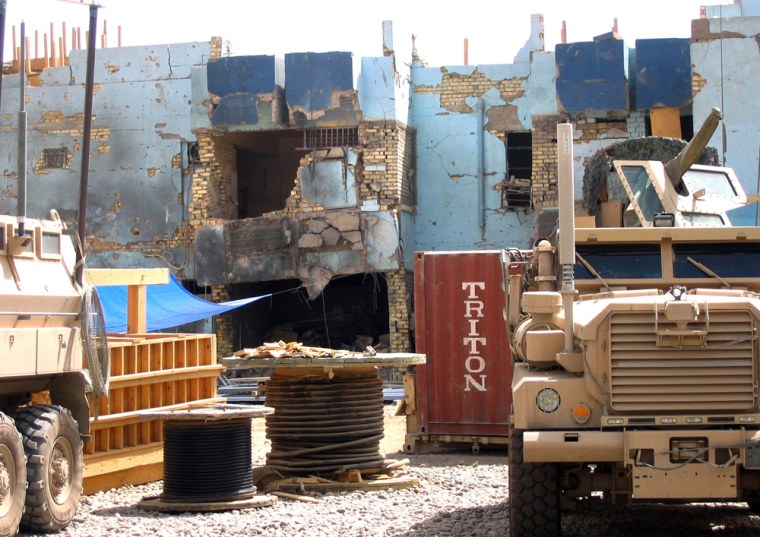U.S. forces may be close to unlocking the mystery of who is behind a deadly innovation in Iraqi insurgents' weapons, a "lob bomb" now being used in Baghdad to target U.S. and Iraqi combat outposts, a senior American general said Friday in an Associated Press interview.
Maj. Gen. Jeffery Hammond, commander of U.S. forces in Baghdad, called the weapon "the greatest threat right now that we face," and he likened the shadowy group behind it to the American military's elite Delta Force.
The weapon is particularly worrying because it is designed to cause catastrophic damage and cannot be stopped once it has been launched, Hammond, commander of the 4th Infantry Division, said in an interview in his office at this U.S. military headquarters compound just west of the capital.
U.S. forces detained a man on Thursday who Hammond said could provide valuable insights into the group behind the bombmaking. "We think we have defined the network," he said. He would not elaborate, although other American officers said in interviews that the group is Shiite and may have links to Iran.
"We think we might have picked up a guy that could lead us — could be a big lead in this," Hammond said.
It's not clear whether this small group is related to efforts by anti-American Shiite cleric Muqtada al-Sadr to revitalize his Mahdi Army, which had held sway in the Sadr City section of Baghdad until U.S. and Iraqi forces wrested control after seven weeks of fighting that ended in May.
Arguing against a link to such an al-Sadr initiative is the fact that the group that Hammond described has been operating since at least late 2007, although it has become more active in recent months.
Rockets are made in Iran
The 107 mm rockets that are used in the improvised bombs — which some call an airborne version of the roadside bombs that through the course of the war have been the leading killer of U.S. troops — are manufactured in Iran, officials said. But some officers cautioned against assuming Iran is directly involved.
The weapons are launched from small trucks and are fired in multiples of four to nine rockets at a time. The detonation is sometimes triggered by a signal from a cell phone, other times by a washing machine timer.
Brig. Gen. Will Grimsley, deputy commander of U.S. forces in Baghdad, said in a separate AP interview on Thursday that for lack of a better term he refers to the group as "the evil militia." He said it is small and exhibits a high degree of technical skill in assembling the weapons and executing attacks.
The military calls the weapon an "improvised rocket-assisted mortar," or IRAM.
Grimsley on Thursday went to the Sadr City section of eastern Baghdad to visit a joint U.S.-Iraqi military outpost that suffered an IRAM attack on April 28. The building was heavily damaged, and 15 U.S. soldiers were wounded, none seriously enough to prevent their return to duty, said Lt. Col. Steven Stover, a military spokesman.
Weapons killed three in 11 attacks
The weapon innovation has gained relatively little public attention because it has yet to kill in large numbers.
So far, in 11 attacks, three U.S. soldiers have been killed, Stover said. The three were killed April 28 — the same day as the Sadr City assault — in an attack on a larger U.S. base in eastern Baghdad.
At the Sadr City base, Grimsley consulted with Lt. Col. Brian Eifler, commander of 1st Battalion, 6th Armor, 2nd Brigade, 1st Armored Division, inside a newly constructed combat outpost a stone's throw from the damaged one. Eifler said he is focused heavily on the IRAM threat and how to minimize it.
Eifler estimated that a U.S. soldier who might be in position to witness the approach of a potential IRAM-bearing vehicle would have less then two seconds to decide whether the person emerging from it has just set it for firing or is simply an innocent driver getting out to change a tire.
"That's a call our young soldiers have to make when potentially 200 lives are at stake," Eifler said.
Hammond said the perpetrators are so skilled that he has likened their organization to the U.S. military's secretive and elite Delta Force. He said they have demonstrated an unusual degree of military skill and cunning.
"They don't leave a forensic trail, and that just means we're going to have to work a little bit longer" to eliminate them, he said. "Of everything we've had to deal with here, this is a tough one. They're sort of the Delta Force of this enemy we face out there. They are very good" at covering their tracks, picking out targets and preserving secrecy about their membership and movements.
